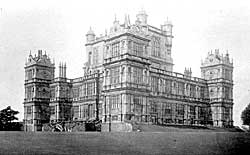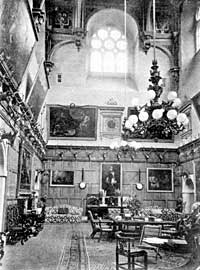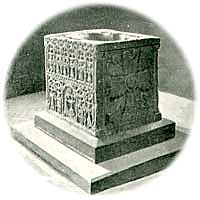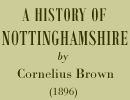< Previous | Contents | Next >
Wollaton Hall and Lenton
 Wollaton Hall in the early 20th century.
Wollaton Hall in the early 20th century.A SHORT drive from Nottingham, with its busy streets and factories, brings us to a scene of tranquillity, in striking contrast to the whirl and hurry of the prosperous county town. Wollaton Hall is one of the stateliest homes of which old England can boast, and the wooded park, where browse the frighted deer, surrounds it with all the beauties of nature, that give to country life its enchantment in both winter and summer. Passing through the entrance at the lodge, the visitor emerges under an avenue of majestic limes three-quarters of a mile in length, and at the extremity stands the hall, described as ‘a combination of elegance and art,’ bearing on its southern front this proud inscription: ‘En has Francisici Willoughbaei aedes rara Arte extructas Willoughbaeis relictas. Inchoatae MDLXXX— MDLXXXVIII.’ It is a crystal palace, combining lightness and grace with imposing stability, and the beauty of its design can best be illustrated by the fact that Sir Joseph Paxton found nothing comparable to it in England, and sent an assistant to obtain models from it for reproduction at Mentmore—Baron Rothschild’s seat.
This splendid Elizabethan mansion, as the inscription testifies, took eight years in its completion, and cost £80,000—an enormous sum in those days. The Ancaster stone used in its construction was supplied in exchange for coal from the pits on the Wollaton estate. The interior of the noble building is no less attractive than its exterior, and its wealth of artistic adornment includes the masterpieces of Giordano, Vandyck, Snyders, Hemskirk, Teniers, Rubens, and others.

The Great Hall of Wollaton Hall as pictured in the mid-20th century.
The early history of the founders of the family will be found touched upon in a chapter on Willoughby-on-the-Wolds, and we now propose to glance at the noble owners of a later period.
One of the most ancient monuments in the church at Wollaton is that to Richard Willoughby, who died in 1471, and Anne his wife, standing on the north side near the altar. They died without issue, and the property passed to Sir Henry Willoughby, whose memorial speaks of him as ‘dominus de Wollaton,’ and who died in 1528. Hugh Willoughby, his third son, was a daring Arctic explorer, and commanded the Bona Esperanza in an expedition in 1553 to discover the North-East Passage to Cathay. It was a scene of wild excitement at Greenwich when the ship, with three others, started on its perilous voyage. Members of the Privy Council went to see it off, and great hopes were entertained of the success of the gallant and adventurous mariners. Unhappily the vessels met with storms off the coast of Spitzbergen, and the Bona Esperanza was driven into a river or haven, called Arzina, in Lapland. Unable to withstand the rigours of the winter, the whole party perished, and the body of Sir Hugh was discovered in a chair, where he had evidently been frozen to death, with his will and the ship’s log-book before him.
On the death of Sir Henry’s eldest son without issue the estate came to Henry, heir of Edward, the second son.
This representative of the great family met with his death in the suppression of Ket’s Rebellion, one of those curious revolutionary movements in the reign of Edward VI. His wife, Anna, sister of Henry Grey, Duke of Suffolk, was left with two sons—Thomas, aged eight, and Francis. The former died, and Wollaton therefore passed to Francis, who was the builder of the palatial dwelling already referred to.
In the publications of the Historical Manuscripts Commission there are several references to Sir Francis. In July, 1593, he was sent by the Lords of the Council to Sawley to inquire into the misconduct of a Mrs. Williamson, and others, towards the messenger sent from the Council to apprehend the ringleaders of a riot committed in plucking down Sir Thomas Stanhope’s weir at Shelford. But his great work was the building of his magnificent house, which remains a noble monument to his own excellent taste, and the wealth of his family.
He had two wives, the first of whom was Elizabeth, daughter of Mr. John Littleton, and the second, Dorothy, relict of John Tamworth. By the first he had four daughters, and their claims, with that of the widow, involved the family in costly law proceedings. Sir Percival Willoughby, of Eresby, married the eldest, Bridget, and thus united the two houses, already related to each other. In the hall are portraits of Sir Percival and his lady, and in the background of Sir Percival’s picture is depicted a ship, with a Latin motto thus rendered, ‘Lost by words, not by winds and waves' —which it is surmised relates to the ruinous legal conflict.
His eldest son, Sir Francis, succeeded to the estates. He was a soldier, and served in the Low Countries, where he lost large sums of money, and his son met his death. He took part in the expeditions to Cadiz, Rhe, and Rochelle, and there is a letter in the State Papers from William Weld, describing a quarrel between a Sir Francis and Sir Lucius Cary. He died in 1665, in the seventy-sixth year of his age, and was succeeded by his son Francis, the celebrated naturalist. His heir, also named Francis, was created a baronet in 1677, with remainder to his brother, Sir Thomas, who, having represented the county in Parliament, was created Baron Middleton of Middleton, in the county of Warwick, in 1711. From him the present noble owner, the ninth Baron, is descended.

Lenton Priory font dates from the mid-12th century.
In immediate proximity to Wollaton is Lenton, where William Peverel, in the reign of Henry I., founded and endowed a Cluniac Priory, the story of which, from its creation to its dissolution, is well told in the recently published history of the parish by Mr. John T. Godfrey.
